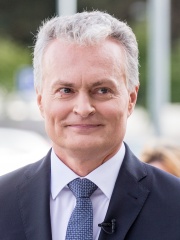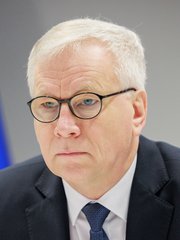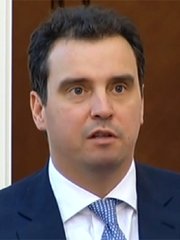







The Most Famous
POLITICIANS from Lithuania
This page contains a list of the greatest Lithuanian Politicians. The pantheon dataset contains 19,576 Politicians, 79 of which were born in Lithuania. This makes Lithuania the birth place of the 44th most number of Politicians behind North Korea, and Estonia.
Top 10
The following people are considered by Pantheon to be the top 10 most legendary Lithuanian Politicians of all time. This list of famous Lithuanian Politicians is sorted by HPI (Historical Popularity Index), a metric that aggregates information on a biography's online popularity. Visit the rankings page to view the entire list of Lithuanian Politicians.

1. Józef Piłsudski (1867 - 1935)
With an HPI of 78.96, Józef Piłsudski is the most famous Lithuanian Politician. His biography has been translated into 79 different languages on wikipedia.
Józef Klemens Piłsudski[a] (Polish: [ˈjuzɛf ˈklɛmɛns piwˈsutskʲi] ; 5 December 1867 – 12 May 1935) was a Polish statesman who served as the Chief of State (1918–1922) and first Marshal of Poland (from 1920). In the aftermath of World War I, he became an increasingly dominant figure in Polish politics and exerted significant influence on shaping the country's foreign policy. Piłsudski is viewed as a father of the Second Polish Republic, which was re-established in 1918, 123 years after the final partition of Poland in 1795, and was considered de facto leader (1926–1935) of the Second Republic as the Minister of Military Affairs. Seeing himself as a descendant of the culture and traditions of the Polish–Lithuanian Commonwealth, Piłsudski believed in a multi-ethnic Poland—"a home of nations" including indigenous ethnic and religious minorities to be assimilated as Poles. Early in his political career, Piłsudski became a leader of the Polish Socialist Party. Believing Poland's independence would be won militarily, he formed the Polish Legions. In 1914, he predicted a new major war would defeat the Russian Empire and the Central Powers. After World War I began in 1914, Piłsudski's Legions fought alongside Austria-Hungary against Russia. In 1917, with Russia faring poorly in the war, he withdrew his support for the Central Powers, and was imprisoned in Magdeburg by the Germans. Piłsudski was Poland's Chief of State from November 1918, when Poland regained its independence, until 1922. From 1919 to 1921 he commanded Polish forces in six wars that re-defined the country's borders. On the verge of defeat in the Polish–Soviet War in August 1920, his forces repelled the invading Soviet Russians at the Battle of Warsaw. In 1923, with a government dominated by his opponents, in particular the National Democrats, Piłsudski retired from active politics. Three years later he returned to power in the May Coup and became the strongman of the Sanation government. He focused on military and foreign affairs until his death in 1935, developing a cult of personality that has survived into the 21st century. Although some aspects of Piłsudski's administration, such as imprisoning his political opponents at Bereza Kartuska, are controversial, he remains one of the most influential figures in Polish 20th-century history and is widely regarded as a founder of modern Poland.

2. Władysław II Jagiełło (1362 - 1434)
With an HPI of 78.54, Władysław II Jagiełło is the 2nd most famous Lithuanian Politician. His biography has been translated into 68 different languages.
Jogaila (Lithuanian: [jɔˈɡâːɪɫɐ] ; c. 1352/1362 – 1 June 1434), later Władysław II Jagiełło (Polish: [vwaˈdɨswaf jaˈɡʲɛwwɔ] ), was Grand Duke of Lithuania beginning in 1377 and starting in 1386, becoming King of Poland as well. As Grand Duke, he ruled Lithuania from 1377 to 1381 and from 1382 to 1401, at which time he became the Supreme Duke of Lithuania in exchange for naming his cousin Vytautas as the new Grand Duke. Władysław II initially served as King of Poland alongside his wife Jadwiga until her death in 1399, and then the sole ruler until his own death in 1434. Raised a Lithuanian polytheist, he converted to Catholicism in 1386 and baptized as Ladislaus (Polish: Władysław) in Kraków, married the young Queen Jadwiga, and was crowned King of Poland as Władysław II Jagiełło. In 1387, he converted Lithuania to Catholicism. His reign in Poland started in 1399, upon the death of Queen Jadwiga, lasted a further thirty-five years, and laid the foundation for the centuries-long Polish–Lithuanian union. He was a member of the Jagiellonian dynasty in Poland that bears his name and was previously also known as the Gediminid dynasty in the Grand Duchy of Lithuania. The dynasty ruled both states until 1572, and became one of the most influential dynasties in late medieval and early modern Europe. Jogaila was the last pagan ruler of medieval Lithuania. After he became King of Poland, as a result of the Union of Krewo, the newly formed Polish-Lithuanian union confronted the growing power of the Teutonic Order. The allied victory at the Battle of Grunwald in 1410, followed by the Peace of Thorn, secured the Polish and Lithuanian borders and marked the emergence of the Polish–Lithuanian alliance as a significant force in Europe. The reign of Władysław II Jagiełło extended Polish frontiers and is often considered the beginning of Poland's Golden Age.

3. Vytautas (1352 - 1430)
With an HPI of 76.28, Vytautas is the 3rd most famous Lithuanian Politician. His biography has been translated into 51 different languages.
Vytautas the Great (; c. 1350 – 27 October 1430) was a ruler of the Grand Duchy of Lithuania. He was also the prince of Grodno (1370–1382), prince of Lutsk (1387–1389), and the postulated king of the Hussites. In modern Lithuania, Vytautas is revered as a national hero and was an important figure in the national rebirth in the 19th century. Vytautas is a popular male given name in Lithuania. In commemoration of the 500-year anniversary of his death, Vytautas Magnus University was named after him. Monuments in his honour were built in many towns in independent Lithuania during the interwar period from 1918 to 1939. Vytautas knew and spoke the Lithuanian language with his cousin Jogaila.

4. Gediminas (1275 - 1341)
With an HPI of 75.42, Gediminas is the 4th most famous Lithuanian Politician. His biography has been translated into 46 different languages.
Gediminas (c. 1275 – December 1341) was Grand Duke of Lithuania from 1315 or 1316 until his death in 1341. Gediminas is traditionally considered to have been the founder of Vilnius, the capital city of Lithuania (see: Iron Wolf legend). During his reign, he brought under his rule lands streching from the Baltic Sea to the Black Sea. The Gediminids dynasty he founded and which is named after him came to rule over Poland, Hungary and Bohemia.

5. Mindaugas (1203 - 1263)
With an HPI of 75.00, Mindaugas is the 5th most famous Lithuanian Politician. His biography has been translated into 49 different languages.
Mindaugas (c. 1203 – 12 September 1263) was the first known Grand Duke of Lithuania and the only crowned King of Lithuania. Little is known of his origins, early life, or rise to power; he is mentioned in a 1219 treaty as an elder duke, and in 1236 as the leader of all the Lithuanians. The contemporary and modern sources discussing his ascent mention strategic marriages along with banishment or murder of his rivals. He extended his domain into regions southeast of Lithuania proper during the 1230s and 1240s. In 1250 or 1251, during the course of internal power struggles, he was baptised as a Roman Catholic; this action enabled him to establish an alliance with the Livonian Order, a long-standing antagonist of the Lithuanians. By 1245, Mindaugas was already being referred to as "the highest king" in certain documents. During the summer of 1253, he was crowned king, ruling between 300,000 and 400,000 subjects, and got nicknamed as Mindaugas the Sapient by the Livonians. While Mindaugas's ten-year reign as king was marked by many state-building accomplishments, his conflicts with relatives and other dukes continued. The western part of Lithuania – Samogitia – strongly resisted the alliance's rule. His gains in the southeast were challenged by the Tatars. He broke peace with the Livonian Order in 1261, possibly renouncing Christianity, and was assassinated in 1263 by his nephew Treniota and another rival, Duke Daumantas of Pskov. His three immediate successors were assassinated as well. The disorder was not resolved until Traidenis gained the title of grand duke c. 1270. Although his reputation was unsettled during the following centuries and his descendants were not notable, he gained standing during the 19th and 20th centuries. Mindaugas was the only king of Lithuania; while most of the Lithuanian grand dukes from Jogaila onward also reigned as kings of Poland, the titles remained separate. Now generally considered the founder of the Lithuanian state, he is also now credited with stopping the advance of the Tatars towards the Baltic Sea, establishing international recognition of Lithuania, and turning it towards Western civilization. In the 1990s the historian Edvardas Gudavičius published research supporting an exact coronation date – 6 July 1253. This day is now an official national holiday in Lithuania, Statehood Day.

6. Algirdas (1296 - 1377)
With an HPI of 73.76, Algirdas is the 6th most famous Lithuanian Politician. His biography has been translated into 40 different languages.
Algirdas (c. 1296 – May 1377) was Grand Duke of Lithuania from 1345 to 1377. With the help of his brother Kęstutis (who defended the western border of the Duchy) he created an empire stretching from the present Baltic states to the Black Sea and to within 80 kilometres (50 miles) of Moscow.

7. Kęstutis (1297 - 1382)
With an HPI of 71.99, Kęstutis is the 7th most famous Lithuanian Politician. His biography has been translated into 33 different languages.
Kęstutis (c. 1297 – 3 or 15 August 1382) was sole Duke of Trakai from 1342 to 1382 and Grand Duke of Lithuania from 1342 to 1382, together with his brother Algirdas (until 1377), and with his nephew Jogaila (from 1377 to 1381). The name "Kęstutis" is a derivative from the old form of the name Kęstas, which is a shortened version of such Lithuanian names as Kęstaras, Kęstautas (there kęs-ti means to cope). Historic writing sources reflect different Lithuanian pronunciation.

8. Dalia Grybauskaitė (b. 1956)
With an HPI of 71.57, Dalia Grybauskaitė is the 8th most famous Lithuanian Politician. Her biography has been translated into 79 different languages.
Dalia Grybauskaitė (Lithuanian pronunciation: [dɐˈlʲɛ ɡʲrʲiːbɐʊsˈkɐ̂ˑɪtʲeː]; born 1 March 1956) is a Lithuanian politician who served as the eighth president of Lithuania from 2009 to 2019. She is the first and so far only woman to hold the position and in 2014 she became the first President of Lithuania to be reelected for a second consecutive term. Grybauskaitė has served as Minister of Finance, as well as European Commissioner for Financial Programming and the Budget from 2004 to 2009. She is often referred to as the "Iron Lady" or the "Steel Magnolia".

9. Antanas Smetona (1874 - 1944)
With an HPI of 71.44, Antanas Smetona is the 9th most famous Lithuanian Politician. His biography has been translated into 49 different languages.
Antanas Smetona (Lithuanian: [ɐnˈtǎːnɐs sʲmʲɛtoːˈnɐ] ; 10 August 1874 – 9 January 1944) was a Lithuanian intellectual, journalist, and politician. He served as the first president of Lithuania from 1919 to 1920 and later as the authoritarian head of state from 1926 until the Soviet occupation of Lithuania in 1940. Referred to as the "Leader of the Nation" during his presidency, Smetona is recognised as one of the most important Lithuanian political figures between World War I and World War II, and a prominent ideologist of Lithuanian nationalism and the movement for national revival. Born into a farming family in the village of Užulėnis, Kovno Governorate, Smetona exhibited a strong interest in education and Lithuanian cultural identity from an early age. He attended Palanga Progymnasium and later graduated from Jelgava Gymnasium. He pursued higher education at the Saint Petersburg Imperial University, where he studied law and became involved in nationalist and cultural movements. During this time, he contributed to the Lithuanian press, advocating for national self-determination and the preservation of Lithuanian culture under Russian imperial rule. After completing his studies, he worked as a teacher and journalist, eventually becoming one of the key intellectual leaders of the Lithuanian National Revival. The Russian Revolution of 1917 and the subsequent collapse of the Russian Empire provided a pivotal opportunity for Smetona and other Lithuanian leaders to pursue national independence. As a member of the Council of Lithuania, he was instrumental in the drafting and signing of the Act of Independence on 16 February 1918, which proclaimed the restoration of an independent Lithuania. During the interwar period, Smetona emerged as a prominent political figure, serving as the first President and later taking power in a coup d'état in 1926. Under his leadership, Lithuania pursued a policy of neutrality and underwent significant economic and cultural development, despite the challenges posed by regional instability and the rise of authoritarian regimes in Europe. After the Soviet Union occupied Lithuania in 1940, Smetona fled to Germany and later to the United States, where he lived in exile until his death in Cleveland, Ohio, in 1944. His legacy remains a topic of debate among historians. While some view him as a pivotal figure in the establishment of Lithuanian independence and the promotion of national identity, others criticize his authoritarian rule and suppression of political opposition.

10. Valdas Adamkus (b. 1926)
With an HPI of 71.36, Valdas Adamkus is the 10th most famous Lithuanian Politician. His biography has been translated into 58 different languages.
Valdas Adamkus (Lithuanian: [ˈvɐ̂ˑɫdɐs ɐˈdɐmˑkʊs] ; born Voldemaras Adamkavičius; 3 November 1926) is a Lithuanian politician, diplomat and civil engineer who served as the fifth and seventh president of Lithuania from 1998 to 2003 and again from 2004 to 2009. Adamkus' first tenure as president lasted for five years, from 26 February 1998 to 26 February 2003, following his defeat by Rolandas Paksas in the 2003 presidential election. Paksas was later impeached and removed from office by a parliamentary vote on 6 April 2004. Soon afterwards, when a new election was announced, Adamkus again ran for president and was re-elected. His approval ratings increased during this period and become a highly regarded moral authority in the state. He was succeeded as president on 12 July 2009 by Dalia Grybauskaitė. He is considered by some as being one of the best Lithuanian leaders in modern history. He was married to Alma Adamkienė, who was involved in charitable activities in Lithuania. Following the end of his term as president, Adamkus remained involved in international development, and is a member of the European Academy of Diplomacy.
People
Pantheon has 79 people classified as Lithuanian politicians born between 1203 and 1990. Of these 79, 32 (40.51%) of them are still alive today. The most famous living Lithuanian politicians include Dalia Grybauskaitė, Valdas Adamkus, and Vytautas Landsbergis. The most famous deceased Lithuanian politicians include Józef Piłsudski, Władysław II Jagiełło, and Vytautas. As of April 2024, 7 new Lithuanian politicians have been added to Pantheon including Inga Ruginienė, Gintautas Paluckas, and Rimantas Šadžius.
Living Lithuanian Politicians
Go to all RankingsDalia Grybauskaitė
1956 - Present
HPI: 71.57
Valdas Adamkus
1926 - Present
HPI: 71.36
Vytautas Landsbergis
1932 - Present
HPI: 69.72
Gitanas Nausėda
1964 - Present
HPI: 67.75
Andrius Kubilius
1956 - Present
HPI: 66.31
Rolandas Paksas
1956 - Present
HPI: 62.65
Kazimira Prunskienė
1943 - Present
HPI: 62.08
Ingrida Šimonytė
1974 - Present
HPI: 61.09
Artūras Paulauskas
1953 - Present
HPI: 59.13
Inga Ruginienė
1981 - Present
HPI: 58.49
Algirdas Butkevičius
1958 - Present
HPI: 58.39
Aharon Barak
1936 - Present
HPI: 57.88
Deceased Lithuanian Politicians
Go to all RankingsJózef Piłsudski
1867 - 1935
HPI: 78.96
Władysław II Jagiełło
1362 - 1434
HPI: 78.54
Vytautas
1352 - 1430
HPI: 76.28
Gediminas
1275 - 1341
HPI: 75.42
Mindaugas
1203 - 1263
HPI: 75.00
Algirdas
1296 - 1377
HPI: 73.76
Kęstutis
1297 - 1382
HPI: 71.99
Antanas Smetona
1874 - 1944
HPI: 71.44
Algirdas Brazauskas
1932 - 2010
HPI: 69.92
Hacı I Giray
1397 - 1466
HPI: 69.26
Gabriel Narutowicz
1865 - 1922
HPI: 67.82
Sigismund Kęstutaitis
1365 - 1440
HPI: 67.17
Newly Added Lithuanian Politicians (2025)
Go to all RankingsInga Ruginienė
1981 - Present
HPI: 58.49
Gintautas Paluckas
1979 - Present
HPI: 55.77
Rimantas Šadžius
1960 - Present
HPI: 52.77
Waldemar Tomaszewski
1965 - Present
HPI: 46.84
Aivaras Abromavičius
1976 - Present
HPI: 44.33
Edvinas Ramanauskas
1985 - Present
HPI: 37.08
Aurimas Lankas
1985 - Present
HPI: 36.39
Overlapping Lives
Which Politicians were alive at the same time? This visualization shows the lifespans of the 25 most globally memorable Politicians since 1700.





















